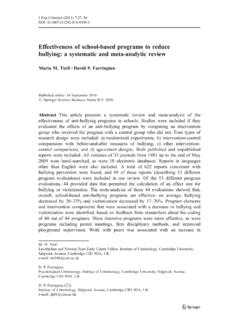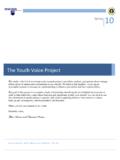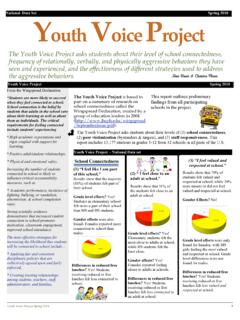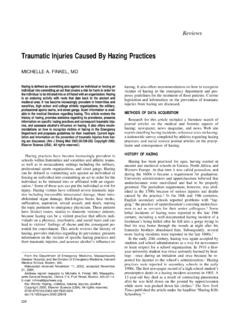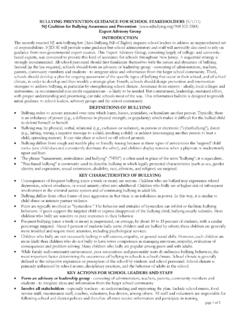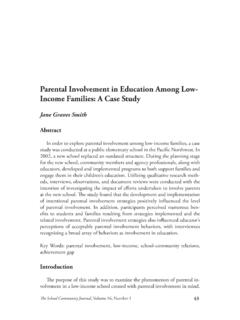Transcription of Sample Newsletter Article:Bullying Among …
1 Sample Newsletter article : bullying Among children and Youth What is bullying ? Victims of bullying also are more likely than other bullying is aggressive behavior that is intentional students to report that they do not want to go to and that involves an imbalance of power or school because of fear of being bullied (Slee, 1994). strength. bullying can take many forms, such as Some children who are bullied decide, in turn, to hitting, kicking, threatening others, teasing, bully others. For all of these reasons, it is important name-calling, excluding from a group, or sending that schools address the bullying problem in mean notes or e-mails. A child who is being bullied their school. has a hard time defending himself or herself. Often, children are bullied not just once or twice but Where does bullying happen? over and over (Olweus, 1993; Roland, 1989; Smith & Most bullying (2-3 times as much) happens at Sharp, 1994).
2 School and on the school bus to and from school (Hoover, Oliver, & Hazler, 1992). bullying also can take How much of a problem is bullying ? place when kids walk to and from school but this is Unfortunately, bullying is very common during the not quite as common. bullying is more likely to elementary and middle school years. In one study happen when large groups of students are of 4th 6th graders, 25% of students admitted to supervised by a small number of adults, including bullying another student several times or more during lunchtime, recess, physical education, and often during the school term (Melton et al., 1998). when kids change classes (Espelage & Asidao, 2001;. Another study found that 80% of middle school Olweus, 1993). Students also report being bullied in students reported engaging in some form of the classroom when their teacher's attention is bullying during the past 30 days; with 15% doing so diverted ( , when the teacher turns around to frequently (Bosworth et al.))
3 , 1999). In a national study write on the board or when the teacher is of more than 15,000 students in grades 6 through distracted helping other students). 10, 17% reported having been bullied sometimes . or more often during the school term, and 19% Do boys and girls bullying in the same ways? reported bullying others sometimes or more often Both boys and girls bully but there are some (Nansel et al., 2001). interesting differences in how they bully. Boys tend to be bullied by other boys, whereas girls are Isn't bullying just part of growing up? bullied both by boys and girls (Melton et al., 1998;. Perhaps this attitude is why bullying is still common Olweus, 1993). The most common form of bullying in American schools. There is a lot of research that for both boys and girls is verbal bullying (teasing, shows that being a victim of a bully can affect name-calling).
4 Boys are more likely to say that they students' self-esteem and how they approach are physically bullied. Girls are more likely to report school (Juvonen & Graham, 2001). Students who are being targets of rumor-spreading and sexual often bullied by other students may have serious comments (Nansel et al., 2001). Both boys and girls levels of depression and anxiety, and they are more engage in what is called relational aggression likely than other students to think about suicide (Knight et al., 2000). Individuals who use relational (Austin & Joseph, 1996; Grills & Ollendick, 2002). aggression tend to exclude students from a group activity (game on playground, party) or they might children and youth. Rather, there are many factors threaten to not be someone's friend unless he/she within a child's environment (his or her family, peer does what they say.)
5 Girls are somewhat more likely group, classroom, school, neighborhood, and than boys, to bully each other through social society) that can contribute to bullying behavior. isolation (Olweus, 2002). Students who bully are more likely to witness violence in their home, have little parental Who takes part in bullying ? supervision, and lack warmth and involvement by bullying often involves groups of students picking their parents (Olweus, 1993). children who bully also on another student (Craig & Pepler, 1997; Espelage & are likely to hang out with others who bully and Asidao, 2001). Within these groups, there often is a feel that they gain their popularity or coolness by ring leader and a number of followers. In addition, teasing other students (Pellegrini et al., 1999). many students observe bullying but do not bullying thrives in schools where faculty and staff necessarily take any action they neither engage in do not address bullying , where there is no policy the bullying nor help stop the bullying .
6 children against bullying , and where there is little and youth are often reluctant to try to stop bullying supervision of students especially during lunch, because they are afraid of being bullied themselves, bathroom breaks, and recess. Negative models of because the want to be part of a popular group, or bullying behavior are also prevalent throughout because they simply are not sure how to help. society especially in television, movies, and video games. Who is bullied? Any child can be bullied. It is important not to What can be done to reduce bullying blame or look for faults in children who are bullied, in school? because nobody deserves to be abused by their The good news is that much can be done to stop peers. However, understanding some common bullying in our schools. A single school assembly, characteristics of children who are bullied may help PTA meeting, or social studies lesson on bullying adults identify children who are likely targets of won't solve the problem, however.
7 What is needed bullying and help protect them from abuse. is a team effort by students, teachers, administrators, Research indicates that children who are bullied parents, and other staff to change the culture, or tend to be socially more isolated than other climate, of schools. Many schools are meeting this children (Espelage & Asidao, 2001, Nansel et al., 2001). challenge. To learn more about bullying and what These children may seem to be easy targets for your school or community can do to address bullying because they have few friends to help to bullying , visit protect them. They also may be shy, sensitive, insecure children (Olweus, 1993). Boys who are bullied are often (though not always) physically weaker than their peers. Educators, parents, and others should be especially watchful for bullying of children with disabilities, since these children are often bullied by their peers.
8 What causes a student to start bullying ? There is no one single cause of bullying Among These and other materials are available online at: References Austin, S., & Joseph, S. (1996). Assessment of bully/victim problems in 8 to 11 year-olds. British Journal of Educational Psychology, 66, 447-456. Bosworth, K., Espelage, D. L., & Simon, T. (1999). Factors associated with bullying behavior in middle school students. Journal of Early Adolescence, 19, 341-362. Craig, W. M. & Pepler, D. J. (1997). Observations of bullying and victimization in the school yard. Canadian Journal of School Psychology, 13, 41-59. Espelage, D., & Asidao, C. (2001). Interviews with middle school students: bullying , victimization, and contextual factors. Journal of Emotional Abuse, 2, 49-62. Grills, A. E., & Ollendick, T. H. (2002). Peer victimization, global self-worth, and anxiety in middle school children .
9 Journal of Clinical Child and Adolescent Psychology, 31, 59-68. Hoover, , Oliver, R., & Hazler, (1992). bullying : Perceptions of adolescent victims in the midwestern USA. School Psychology International, 13, 5-16. Juvonen, J., & Graham (2001). Peer harassment in school: The plight of the vulnerable and victimized. New York, NY: Guilford Press. Knight, G. P., Guthrie, I. K., Page, M. C., & Fabes, R. A. (2002). Emotional arousal and gender differences in aggression: A meta-analysis. Aggressive Behavior, 28, 366-393. Melton, G. Limber, S. Flerx, V. Cunningham, P., Osgood, , Chambers, J., Henggler, S., & Nation, M. (1998). Violence Among rural youth. Final report to the Office of Juvenile Justice and Delinquency Prevention. Nansel, , Overpeck, M., Pilla, , Ruan, , Simons-Morton, B., & Scheidt, P. (2001). bullying behaviors Among US youth: Prevalence and association with psychosocial adjustment.
10 JAMA, 285 (16), 2094-2100. Olweus, D. (1993). Bully/victim problems Among schoolchildren: Long-term consequences and an effective intervention program. In S. Hodgins, Mental Disorder and Crime (pp. 317 - 349). Thousand Oaks, CA: Sage Publications. Olweus, D. (February, 2002). Personal communication. Pellegrini, , Bartini, M., & Brooks, F. (1999). School bullies, victims, and aggressive victims: Factors relating to group affiliation and victimization in early adolescence. Journal of Educational Psychology, 91, 216-224. Roland, E. (1989). A system oriented strategy against bullying . In E. Roland & E. Munthe (Eds.), bullying : An international perspective. London: David Fulton Publishers. Slee, (1995). Peer victimization and its relationship to depression Among Australian primary school students. Personality & Individual Differences, 18, 57-62.

